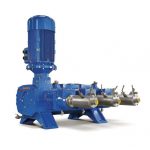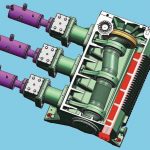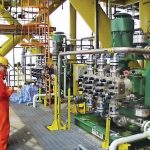Triplex pump motors made by Lewa are known for being very robust. They are used, for example, in the oil and gas industry in injection pumps for monoethyl-ene glycol and methanol as well as in the process industry in reactor pumps for vinyl acetate and for metering ammonia under high pressure. Until now the tri-plex family has comprised six sizes. Since the G3M was developed for use in LNG vessels in Qatar, an intermediate size with a stroke length of 120 mm has also been available.
Author Thomas Bökenbrink Product Manager, Lewa
Highly toxic heavy oil, a waste product of petroleum refineries, is still blown into the air through tanker funnels without being filtered. To reduce the burden on the environment, especially near the coast, while improving its ability to react to price fluctuations, Qatar wants to organise its entire LNG fleet more flexibly in future. The dual-fuel engines developed by MAN Diesel & Turbo for this purpose can optionally be operated with heavy oil or using the liquefied natural gas in the hold. To do this, the boil-off gases are reliquefied under high pressure and injected into the ship’s engine. Since the vessels are permanently operational and only taken into dry dock for maintenance once every five years, the high-performance pumps chosen for this task must be extremely robust and temperature-resistant. One of the prime candidates to supply these pumps is Cryostar SAS, a specialist for cryogenic gases. As a partner of the French manufacturer, Lewa GmbH was entrusted with the development of a new motor that meets the strict requirements for this application.
New use for boil-off gases
Heavy oil is easily obtained, difficult to burn and can be fed into the engine at low pressure. When the large carrier vessels in the Q-flex and Q-max LNG fleets were built nine years ago, a decision was therefore taken to use slow-running diesel engines, since these are also ther-mally more efficient than steam turbines and consume less fuel. In the foreseeable future, though, tankers like those in Qatar will be forced to switch to other fuels on environmental grounds – at least near the coast. Yet carrier vessels with dual-fuel engines like the ones the Emirate is planning to deploy are new territory for everyone involved. Many ship owners consider the technical risk too high because LNG can only be transported safely in the liquid state at very low temperatures. On the other hand, one reason why the option of using on-board natural gas as fuel is becoming increasingly attractive is that engine efficiency is improved compared to when heavy oil is utilised.
The challenge for the vessels is that liquefied gas heats up while they are in motion and is partially converted back to its gaseous state, meaning that its volume grows by a factor of 600 and the pressure in the storage tanks rises. Venting these boil-off gases harms the environment and reduces the profits of both the manufacturer and the charter company. The gases are therefore reliquefied instead by the Q-flex and Q-max LNG fleets. This led to the idea of making the gas available to propel the vessel. Additional equipment is consequently needed to make the fleet more flexible in its choice of fuel and enable it to react to current prices in the export country. If gas is trading high there, it is better to sell it than to burn it in the ship’s engine. If the opposite is true, it pays to operate the vessel with LNG. However, since the gas is extremely explosive, special – absolutely tight – equipment that can withstand both the temperatures and the high pressures is called for.
Special equipment
Both companies are ideally prepared for this application thanks to the triplex pumps developed jointly by Cryostar and Lewa. The French company is a pioneer in this area and designed the pump heads to meet the requirements for cryogenic liquefied gases. The corresponding G3M triplex motor is a bespoke model from the Leonberg system builder. Cryostar has the know-how necessary to work with cryogenic gases at temperatures from -160 to -200 °C while Lewa has the robust, low-maintenance motor technology that is essential for long-term operation. With a rod force of 125 kN, the G3M transforms the rotary motion into an oscillating movement, achieving a maximum power of 160 kW. The development project also filled a gap in the manufacturer’s portfolio. With its 120 mm stroke length the G3M is positioned in the middle of the triplex motor family, which currently comprises seven sizes. The G3S, with a stroke length of 60 mm and a maximum piston rod thrust of 35 kN, is the smallest model while the G3T is the largest with a stroke length of 270 mm and 300 kN rod thrust.
Designed for long-term loading
When developing the new motor, Lewa was able to make use of experience gained with the G3M’s sister models. These are used, for example, in the oil and gas industry in injection pumps for monoethylene glycol (MEG) and methanol as well as in the process industry in reactor pumps for vinyl acetate and for metering ammonia under high pressure. Triplex motors are also employed as injection pumps for suspensions in wet oxidation applications in the process industry and to inject condensate in oil and gas plants. They are the basis there for oscillating positive-displacement pumps and have demonstrated their toughness for decades in a wide variety of climate zones including the Arctic, the tropics and deserts. The motors are even used successfully in the offshore sector.
The G3M combines the positive features of all these models in one package. All of them are characterised by a constant stroke length and built with an integrated worm gear that is noted for its high loading capacity. The compact design is realised with a monoblock housing, to which the motor is flanged vertically. This construction allows the number of bearings and seals to be reduced to a minimum. The connection to the motor is made using a proven coupling with a flexible intermediate element. A perfect phase offset between the three pistons is achieved using a single, mas-sive crankshaft with three crank bends. The shaft only needs two roller bearings as a result, whereas plain bearings are used for the connecting rod to ensure better damping of dynamic loads. Since external lubricant supplies are prone to malfunction, all moving parts are lubricated by means of an oil bath or submersion. All motor components are designed for long-term loading, so that trouble-free operation is possible for more than 40,000 hours. The flow rate is controlled by a frequency converter which regulates the number of strokes per minute – and hence the flow rate – by varying the motor speed.
The first prototype from Cryostar and Lewa is currently at the testing phase. If the results of these tests and the first voyages under load are positive, the system will then be tested on a vessel under real conditions. The costs for conversion are estimated to be about 15 million US dollars per ship, with the total order volume for all 45 vessels in the Q-flex and Q-max fleets amounting to 700 million dollars.
cpp-net.com/0114447
Share:









